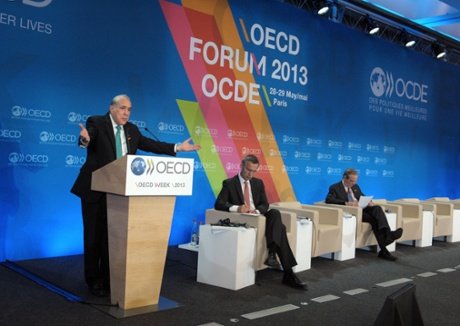
The OECD has revised its growth forecasts for the eurozone and called on the European Central Bank to consider doing more to boost growth.
The organization says the eurozone will shrink by 0.6% this year, widening the gap between it and faster-growing economies such as the US and Japan.
Meanwhile, the European Commission has given France two more years to complete its austerity programme.
France fell back into recession in the first three months of the year.
Spain, Poland, Portugal, the Netherlands and Slovenia have also been given more time to complete fiscal tightening.
The move suggests a shift away from a focus on austerity in Europe.
In its twice-yearly Economic Outlook, the OECD said prolonged economic weakness in Europe could damage the global economy.
The OECD, which represents 34 advanced economies, forecast average growth across its members of 1.2% this year and 2.3% in 2014.
It painted a troubled picture of the eurozone economy. The forecast of a 0.6% contraction in GDP is down markedly from the 0.1% contraction forecast just six months ago.
It said eurozone unemployment would continue to rise from its current rate of 12%, stabilizing in 2014.

It blamed continuing austerity measures, weak confidence and tight credit conditions. It hinted that the European Central Bank (ECB) might want to expand quantitative easing (QE) as a measure to encourage stronger growth.
It warned the continuing weakness in Europe “could evolve into stagnation, with negative implications for the global economy”.
The US and Japan have seen a greater focus on stimulus measures compared with Europe, where austerity measures have taken precedence.
Japan is forecast to grow relatively strongly this year, adding 1.6% to its GDP on the back of extraordinary economic stimulus measures introduced by the government this year.
But the OECD said there was considerable uncertainty over whether that recovery would continue into 2014, when the government is expected to cut spending.
In the US, where growth of nearly 2% is forecast for this year, the OECD said quantitative easing measures might need to be “gradually reduced”.
China is not included in the OECD club, but the organization expects its annual growth to be about 8% over the next two years.
The OECD’s chief economist, Pier Paolo Padoan, told Reuters that the eurozone remained the dominant area of concern.
“Europe is in a dire situation,” he told the news agency.
“We think that the eurozone could consider more aggressive options. We could call it a eurozone-style QE.”
[youtube lo8eiZBe7rg]